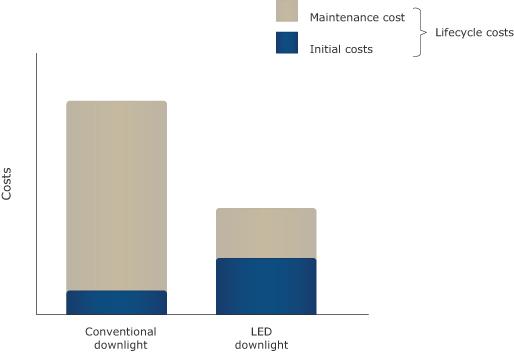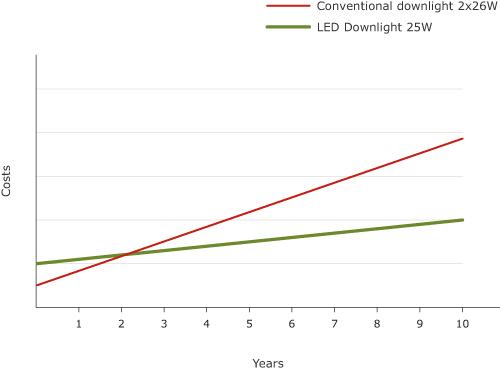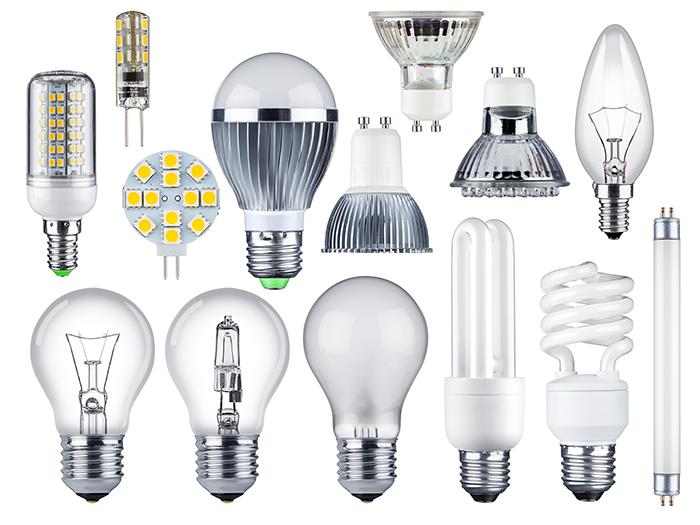LED have been touted as the future of lighting. They have several advantages thus making them very attractive to designers and property developers. These include; long life, high efficacy, easy controllability, low maintenance costs. These attributes hugely determine the price of an LED. In many scenarios, the higher the price, the higher the quality of the LED. Hence, it is key to be familiar with some of the important factors so that you will not be duped by cheap pricing. For, cheap is expensive.
LEDs have their shortcomings as well. They being very small with a relatively high power consumption need correct heat dissipation to ensure that their main advantage of long life is achieved. All LED chipmakers have a range of chips – some for domestic low cost market and some for high-end commercial market. Expecting the same performance and life from a low-end item as one that costs double is naïve.
Important factors to consider.
- UGR (Universal Glare Ratio)
- LED Life rating – L70 VS L90.
- LED Drivers.
- RIPPLE CURRENT.
- LUMENS/WATT
UGR (universal glare ratio)
UGR (Unified Glare Rating) is a method of calculating glare from luminaires, light through windows and bright light sources. The UGR rating helps to determine how likely a luminaire is to cause discomfort to those around it. For example the discomfort that a LED Panel will cause the work force within an office. This classification ranges from 5 to 40, with low numbers indicating low glare. Glare can be a common problem in workplaces. Inappropriate luminaires cause excessive brightness to be “bounced off” reflective surfaces, such as computer screens, whiteboards etc. This can cause disruption for the occupants of offices, in terms of headaches & eye trouble, which can then lead to employee absences.
UGR is calculated by using an equation, which takes into account a number of factors that may contribute to glare caused by a luminaire, such as the angle of the luminaire, the likelihood of glare and the luminance value (lumen output). The equation that is used to calculate the UGR is:

L= The luminance value of the luminaire
Lb= The value of the background luminance
ω= The solid angle of the luminaire that is seen by the viewer
p= The Guth Index. Based on the likelihood of glare, also known as Visual Comfort Probability
Σ= Shows that the equation (shown above) includes all the fittings located within the area.
UGR (universal glare ratio) is important for office spaces, especially where computers are used. Generally, a UGR < 19 for general areas and UGR < 15 for CAD/DTP areas to prevent disabling glare off computer screens.
There are two methods to reduce the glare that is present in relation to interior lighting: firstly, to use luminaires that are UGR<19 rated; secondly to ensure that the lighting design is appropriate for the environment they are being used in i.e. the correct number and position of luminaires.
Within an office setting, for the luminaire to be classified as “low glare” it must have a UGR below 19 at desk level. Anything above this may cause discomfort – this further enforces the need for high quality interior lighting that is rated UGR<19.There are a number of different UGR limits that should not be exceeded in certain environments, these include:
| UGR Rating | Environment |
| UGR ≤ 16 | Technical drawing |
| UGR ≤ 19 | Reading, writing, training, meetings, computer-based work |
| UGR ≤ 22 | Craft and light industries |
| UGR ≤ 25 | Heavy industry |
| UGR ≤ 28 | Railway platforms, foyers |
LED Life
One of the benefits of the LED is its long lifetime. Because they have no movable parts or filaments that may break, LED’s can have long lifetime. The amount of light from the light source at a specific time in the future is referred to as the lamp lumen maintenance factor, or LLMF. The lifetime of a LED module is defined as the time it takes until its light output, or lumen maintenance, reaches 70% of the initial output. This is also called L70. In other words, the module does not die instantly as many conventional light sources do, it slowly dims down. Lighting planners consider this effect when they dimension the lighting installation. As they want the light level to reach a minimum lux value at the end of the lifetime, they over-dimension the luminaire installation, often by using more luminaires. Therefore, the lux value in the beginning of the operating life of the lighting installation is higher than what it is at the end. The luminaire industry has standardized LED lifetime to L70 = minimum 50000 hours, which corresponds to an LLMF of 0.7 as long as the lifetime of the lighting installation is set to the same amount of hours.
In summary:
- LED as a light source is different to others as its life is not measured by the hours to
failure, but hours to a certain percentage of initial light output. The lifetime of a LED module inside a luminaire is related to the luminous flux depreciation at a given ambient temperature. L70, L80 or L90 indicates how many lumens (in percentage related to the initial lumens) that remains after end-of-life. - Life designation for LED products consists of two values – Lxx and Bxx. The L sets the
output percentage of initial and the B sets the percentage of the total that does not
comply with L. Therefore, a L70 B50 shows that 50% of the LEDs are at 70% or more of the initial output. - So Life L70B50 = 50 000 hours is vastly different to Life L80B10 = 50 000 hours
(50,000 hours L70B50 equivalent = +25 000 hoursL80B10).
B value explained further;
The failure fraction for Bxx expresses only the gradual light output degradation as a percentage y of a number of LED modules of the same type that at their rated life designates the percentage (fraction) of failures. The value B50 indicates that the declared L-value will be achieved by minimum 50 % of the LED modules and that the remaining 50% may have a lower lumen value. The value B10 means that minimum 90 % of the LED modules will meet the declared L-value and only 10% will have a lower flux level. A B10 value is therefore more conservative than B50. In practical terms, it means that B10 is reached at an earlier stage in the lifetime on a set of LED modules compared to B50.
Why is the L-value so important?
The L-value is directly related to the maintenance factor (MF) used when making a light calculation. MF includes the following parameters:
MF=LLMF x LSF x LMF x RSMF
- LLMF = Lamp Lumen Maintenance Factor
- LSF = Lamp Survival Factor. The LSF factor can be ignored (set to 1.0) if the luminaires are replaced immediately after failure.
- LMF = Luminaire Maintenance Factor. Depends on type of luminaire, how clean is the environment and finally the cleaning interval of the luminaire. Normal values for interior use are between 0.93–0.98 for clean environments.
- RSMF = Room Surface Maintenance Factor. Depends on reflectance factors in the room, how clean is the environment and finally the cleaning interval of the room. Normal values for interior use are between 0.95–0.97 for clean environments.
LLMF is the same as the L-value. L80 corresponds to a LLMF of 0.8. In order to find the correct L value you must first define the correct required lifetime and the correct required ambient temperature (Ta).
LED Drivers
- LED is driven by direct current which needs to be limited, as if not controlled,
the current will just increase with the reduction in resistance as the temperature increases. - There are two ways of doing this – Constant Current and Constant Voltage, which requires a current limiting device mounted to the LED board – which reduces the efficiency.
- There are different levels of driver – lower level with fixed output settings, intelligent drivers where the current can be set by means of resistors or DIP switches and Dimmable addressable drivers that can be set by means of software/wireless programmers.
- High quality drivers also have much lower ripple current characteristics, longer life and higher efficiencies.
- Driver life is indicated by a similar designation to LED life – eg. F10 = 100 000 hours = 10% failure rate after 100 000 hours.
The lifetime for the LED module and the driver should be declared separately. If the lifetime for the driver is shorter than that of the module, a driver replacement may be necessary before the luminaire’s lifecycle is completed. This means that there cannot be a single figure declaring the total luminaire lifetime. A helpful metric for “median useful life” has been introduced in IEC 62717. This is the time elapsed until 50% of the LED-luminaires in use reaches the stated light output, for example L80.
Ripple current, Flicker, Shimmer and Ripple.
Lighting oscillation characterized by flickering and sometimes shimmering between on and off is universally a bad experience – to consumers; lights should be either on or off. The human eye easily detects low-frequency oscillation in output light amplitude (intensity). Therefore, lighting designers must attempt to minimize any periodic disturbances below 2x the line frequency (< 100 Hz) to avoid unacceptable (detectable) variations in light output.
- Ripple current is the amount of flicker experienced with LED drivers.
- A value of less than 10% for general office applications is acceptable (< 1% for broadcasting studios) – with cheaper drivers having values of greater than 30%.
- Excessive flicker increases eye fatigue and can cause migraines to people with these sensitivities and will be very detrimental to people with epilepsy.
Efficacy – Lumens/Watt
The overall efficacy of LED luminaires is defined as the net luminaire light output divided by the total input power to the luminaire =lumens/Watt.
There is no question that the LED is an efficient light source. Nevertheless, even the LED is subject to physical limits when it comes to luminous efficacy. The theoretical maximum luminous efficacy always depends on the desired spectrum. Big advances cannot be expected nowadays.
Cost-benefit analysis
The introduction of LEDs has led to a rush among customers, architects and specifiers to use the new technology in new and modernized buildings.
However, to use LEDs should be done with care. Not all applications are suitable for an LED installation. For example, the higher cost price of a LED luminaire compared to one using a conventional light source may not be recouped during the installation’s lifetime. Therefore, a total cost of ownership approach is crucial, analyzing investment in luminaires, energy costs, lamp shift cost, cleaning costs and others. In addition, sensors should be taken into account, since they will reduce energy costs and increase luminaire lifetime further. In most cases, a LED solution’s annual costs including capital costs would be lower than that of a conventional solution. The initial investment in the LED installation may be higher than a traditional lighting installation, but the LEDs lower energy consumption and maintenance cost may provide a lower total cost over the lifetime of the installation.
A note for planners & consultants:
- Look carefully and always use your common sense.
- Providing customers with a viable lamp life is an important service the electrical contractor can supply, but you first need a good product and a thorough understanding of the influencers on a LED bulb or fixture’s life.
- You need to be significantly more thoughtful when considering LEDs validating claims of energy savings, color rendition, ambiance, dimming ability, and impacts on product life that may also affect lumen output. Owners that say we want LED lighting are simply specifying the category of lighting they want. You have to speak to how it’s applied, installed [and] used [to] provide the lighting solution.
- Though LED lamps may have the same part numbers, their chips may come from a variety of manufacturers. That can be a factor in performance and product life. You can extend LED lighting life by replacing failing components, but such components are not off the shelf available.
- Encourage proper maintenance of LED lighting to help extend product life. It is also a way in to extend a relationship with a customer.
- Help your clients understand how long their LED solutions should be expected to last.
- Customer expectations of LED lighting will be different based on use, be it an office, warehouse or outdoor setting.



